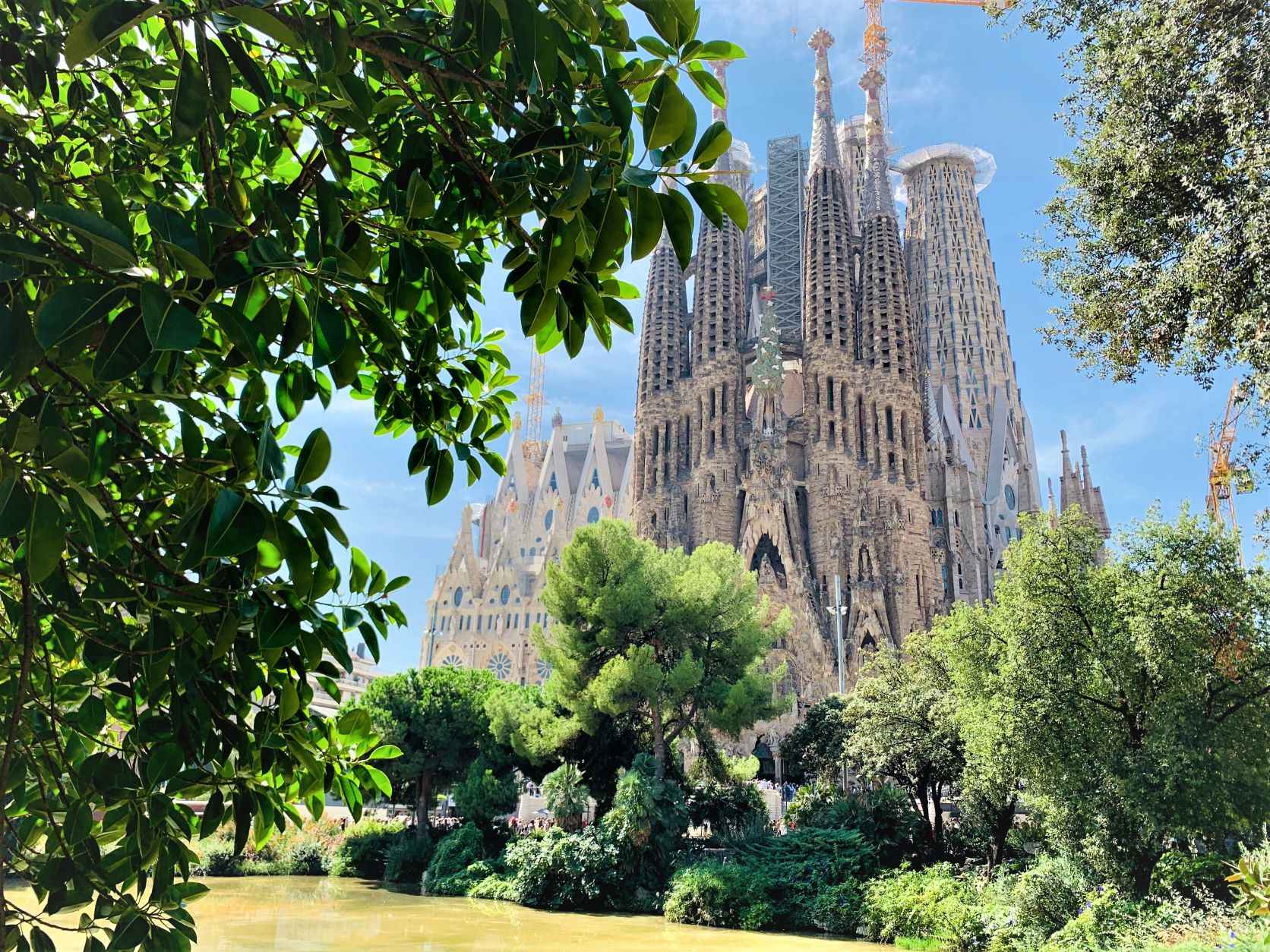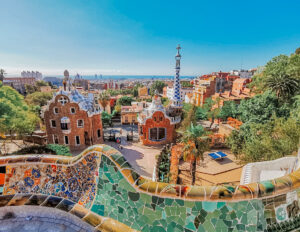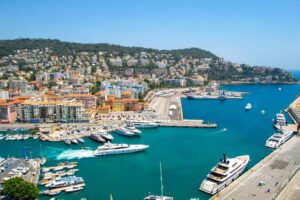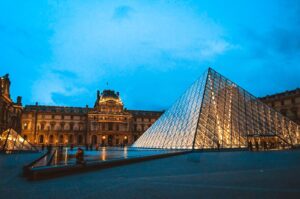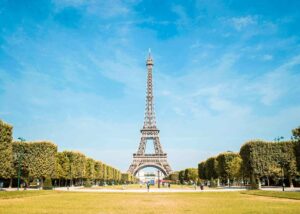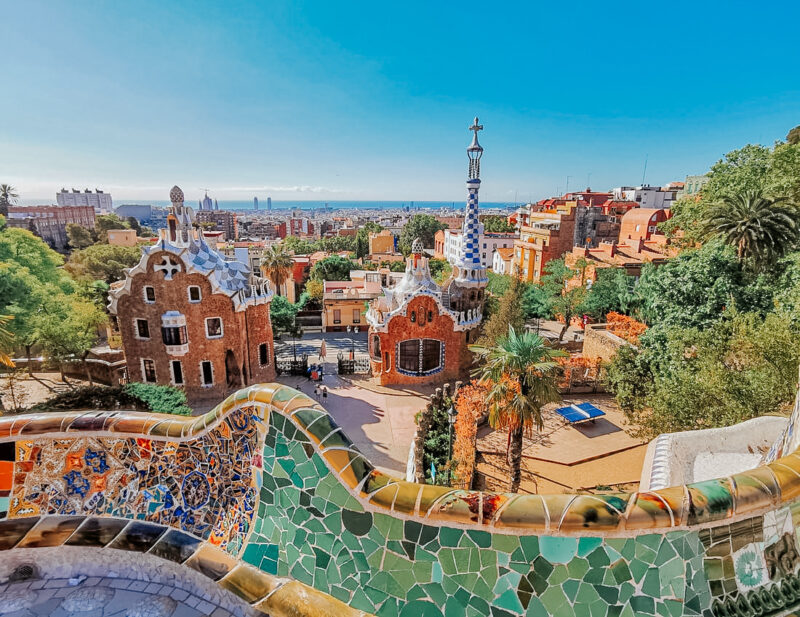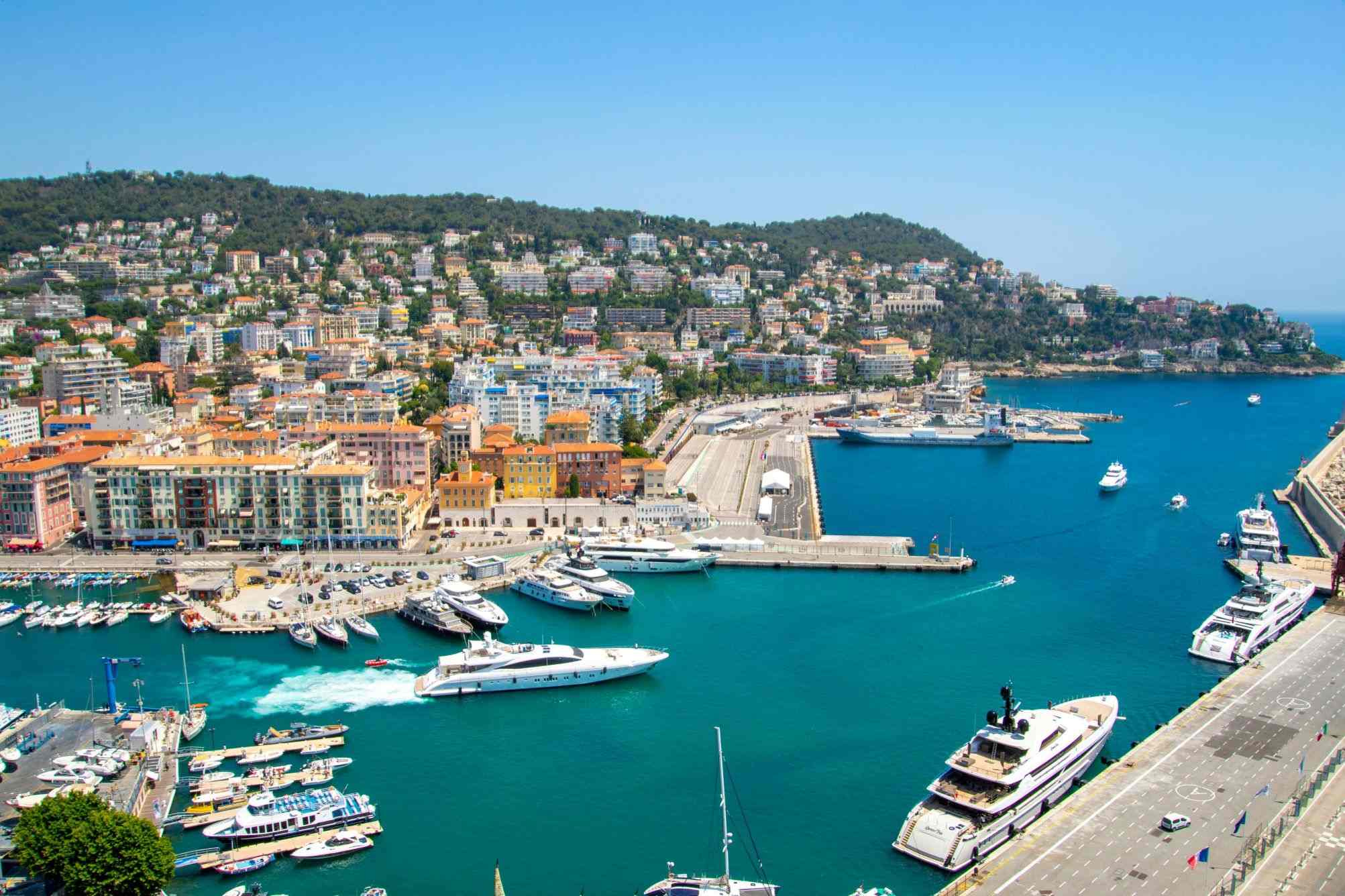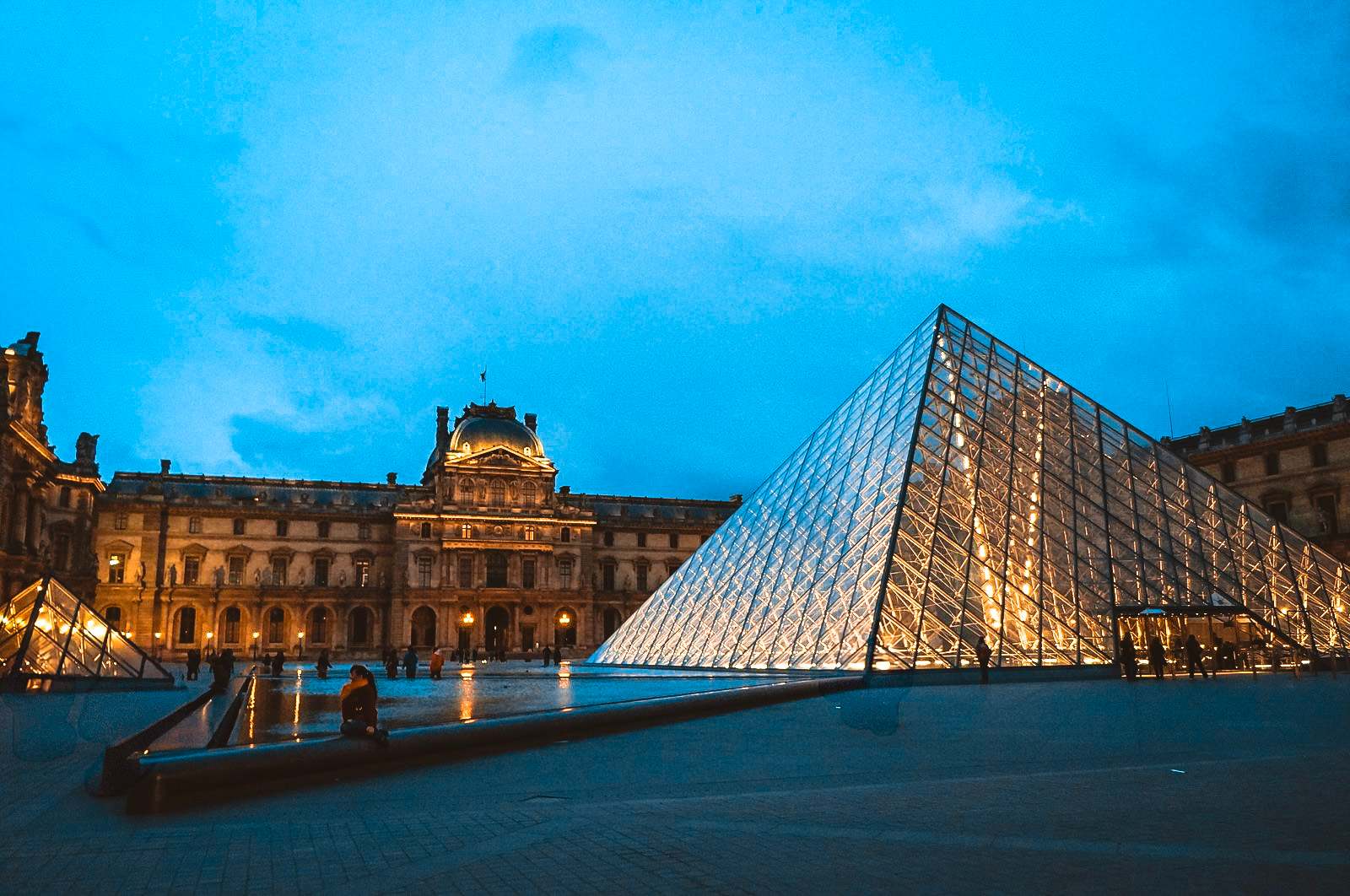Visiting Barcelona in January: Top Barcelona Attractions
Barcelona, the capital of Catalonia, offers a year-round allure, but visiting Barcelona in January provides a special kind of magic. With fewer tourists, mild winter temperatures, and a vibrant calendar of events, the city allows visitors to explore at a slower pace while experiencing its true essence.
Whether it’s soaking in the beauty of Gaudí’s architecture, indulging in Catalonian winter cuisine, or participating in unique festivals, January brings an unexpected charm. We’ve put together a list of everything you need to know for your visit to Barcelona in January. This comprehensive guide will walk you through the best things to see, do, eat, and celebrate in Barcelona during the first month of the year.
** Disclaimer: Please note some of the links in this post are affiliate links. Purchasing through these links earns us a small commission at no extra charge to you.
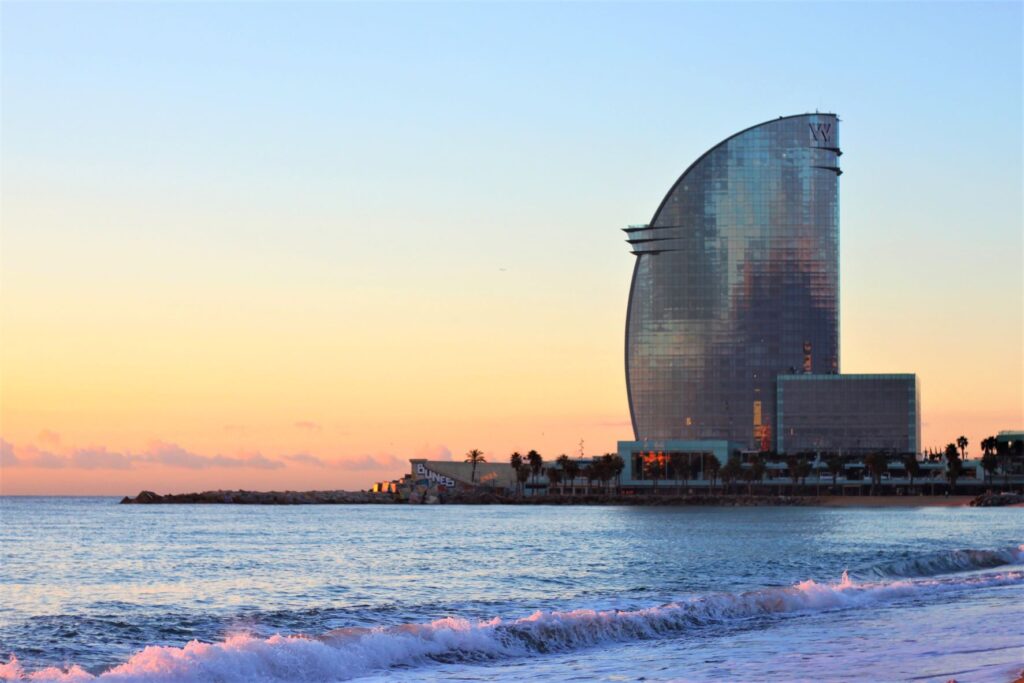
Table of Contents
ToggleWhy Visit Barcelona in January?
While many prefer warmer months, visiting Barcelona in January comes with several benefits.
- The city’s winter weather is mild, ranging from 8°C to 15°C (46°F to 59°F), making it perfect for walking tours and outdoor activities without the scorching heat.
- Another major advantage is the significant reduction in tourist numbers. You can explore top landmarks like La Sagrada Familia and Park Güell without long lines, and restaurants and cafés feel more intimate with locals enjoying their downtime after the holidays.
- Plus, for budget-conscious travelers, January often means lower prices for both flights and accommodation.
- Most notably, January kicks off with the spectacular Three Kings Parade and continues with festive events like Sant Antoni Festival and the beginning of the city’s massive winter sales. From exploring its top attractions to enjoying off-the-beaten-path spots, Barcelona offers plenty in January. Let’s dive into the best things to do.
It is important to note that:
- If you prefer warmer temperatures, this may not be the time for you to visit Barcelona.
- If you are looking for a beach holiday, the water maybe a bit too cold for swimming at this time of the year.
- Some tourist attractions,shops and restaurants may have reduced hours or be closed for the holiday season.
How is the Weather in Barcelona in January?
Barcelona’s winter weather is relatively mild compared to other European cities. In January, daytime temperatures range between 8°C to 15°C (46°F to 59°F). While the mornings and evenings can feel crisp, especially near the sea, the daytime often feels comfortable, especially under sunny skies. January is one of the driest months, with fewer rainy days, allowing you to enjoy the outdoors without worrying about being drenched.
The cooler weather makes January perfect for exploring Barcelona on foot, from wandering around the Gothic Quarter to hiking up to Montjuïc Castle. Sunny afternoons can even feel warm enough to enjoy a coffee or meal at an outdoor terrace.
Does it Snow in Barcelona in January?
Snow in Barcelona is extremely rare, even in January. The city’s Mediterranean climate keeps temperatures mild, with average lows rarely dipping below 7°C (45°F). Although the surrounding hills may see a dusting of snow occasionally, you are unlikely to encounter snow in the city itself. However, if you’re a snow enthusiast, the nearby Pyrenees Mountains offer excellent skiing and snowboarding opportunities and are just a few hours’ drive away.
How Are Prices in Barcelona in January?
January is considered the off-season for tourism in Barcelona, so you’ll benefit from lower prices across the board. Flights and accommodation are generally cheaper compared to the peak summer months, with many hotels offering discounted rates. Additionally, the post-holiday period means that restaurants, attractions, and shops are less crowded, and you may even find special deals at popular tourist sites.
Shopping enthusiasts can also take advantage of the winter sales (rebajas) that begin in early January, with discounts on clothing, accessories, and home goods in stores throughout the city.
What to Pack for Traveling to Barcelona in January
Packing for Barcelona in January requires layering, as temperatures can fluctuate throughout the day. Here’s a helpful guide on what to bring:
- Warm Layers: Mornings and evenings can be chilly, so pack a warm jacket, scarves, and sweaters. However, the daytime can feel mild, so lighter layers like long-sleeve shirts and t-shirts are useful.
- Comfortable Walking Shoes: Barcelona is a city best explored on foot, so bring comfortable shoes for walking around the city’s cobblestone streets.
- Waterproof Jacket: While January is relatively dry, it’s always a good idea to bring a light waterproof jacket in case of unexpected rain.
- Accessories: A warm hat, gloves, and sunglasses can be useful for cooler days and sunny afternoons.
Top Attractions to Visit in Barcelona in January
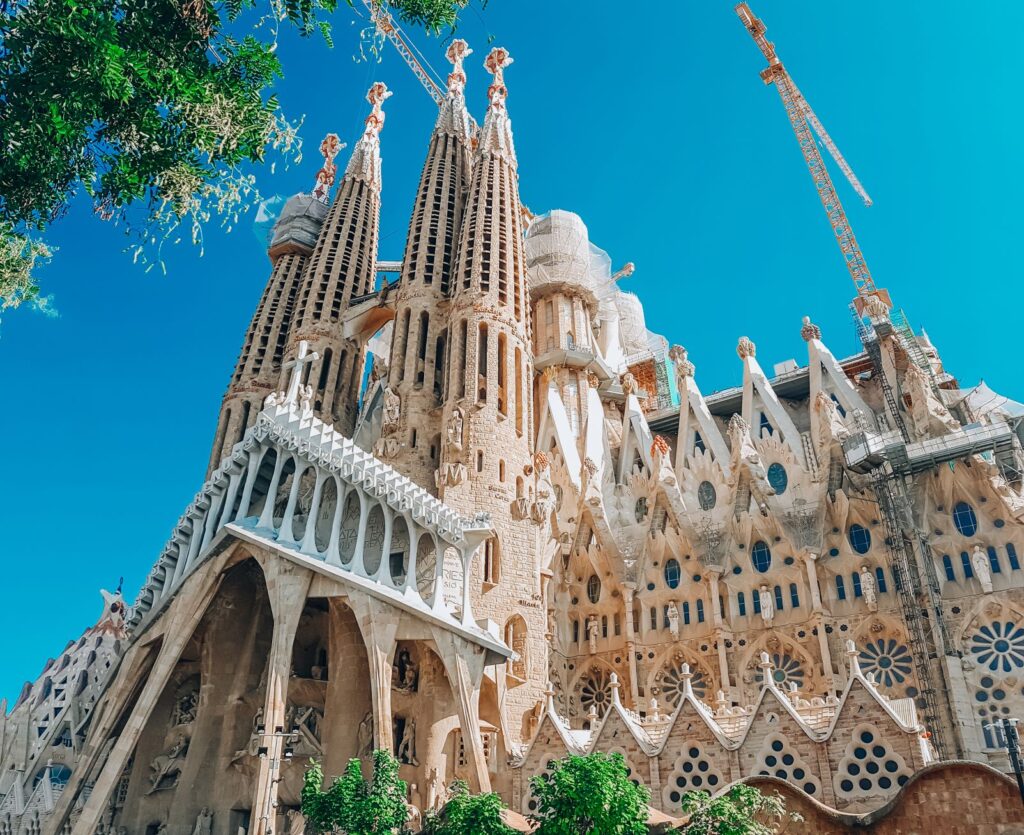
1. La Sagrada Familia
Gaudí’s work of art, the Sagrada Familia, is a must-see no matter when you visit Barcelona. This unique basilica, which has been under construction since 1882, remains one of the most iconic landmarks in the world. The towering spires and intricate facades tell biblical stories, while the inside is filled with colorful light streaming through stained glass windows. Visiting in January means smaller crowds, allowing you to truly take in the awe-inspiring design and details. This skip-the-line tour will take you through all the main points of interest inside the church.
Travel Tip: If you visit in the afternoon, the sunlight streaming in diagonally through the stained glass is just beautiful. While you can explore the basilica on your own, consider booking a guided tour to understand Gaudí’s vision in greater depth. Tours in January are easier to book as they aren’t as full compared to peak season.
2. Park Güell
Another of Gaudí’s masterpieces, Park Güell offers panoramic views of Barcelona and a unique design that makes it feel like a fantasy park. Its vibrant mosaics, whimsical architecture, and garden pathways are delightful, especially in January when the cool air and tranquility make it even more magical. It’s best to buy tickets in advance so you are well prepared on the day. You maybe interested in this Gaudi Bundle which includes pre-booked timed entry to both attractions, Sagrada Familia and Park Güell, as well as an audioguide that covers them both.
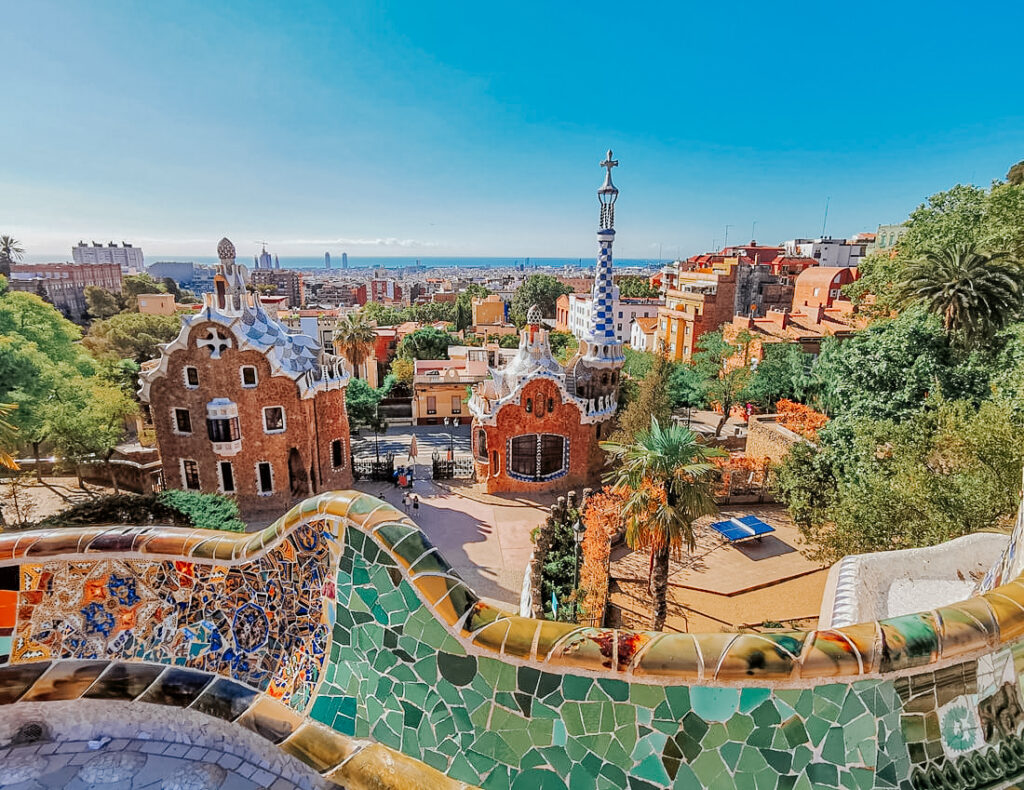
Fun Fact: Park Güell was originally intended as a residential area, but the project was abandoned and transformed into a public park.
Tip for visiting in January: Take advantage of the quieter atmosphere and visit during the late morning for the best lighting and cooler temperatures. The benches are perfect for sitting down and soaking in the view without worrying about the heat or crowds.
3. Casa Batlló and Casa Milà (La Pedrera)
Two of Gaudí’s most famous modernist buildings, Casa Batlló and Casa Milà (also known as La Pedrera), are architectural wonders. Located on Passeig de Gràcia, these structures display Gaudí’s brilliance in playing with shapes, light, and colors.
Casa Batlló’s façade appears almost skeletal, while Casa Milà’s wave-like stonework stands out for its unusual design. January offers the chance to enjoy both buildings at a leisurely pace, with fewer tourists around.
Tip: In January, Casa Batlló offers an immersive audiovisual experience, where you can see the building’s interior through augmented reality. The night tours, where the façade is illuminated, also provide a unique viewing experience.
4. Gothic Quarter (Barri Gòtic)
Barcelona’s Gothic Quarter is the oldest part of the city, home to winding medieval streets, Roman ruins, and gothic cathedrals. In January, the streets are quieter, allowing you to explore at your own pace. Visit Plaça Reial with its palm trees and vibrant nightlife, or stop by Catedral de Barcelona, a gothic marvel that sits at the heart of the district. Don’t miss the Pont del Bisbe, a neo-gothic bridge that feels like something out of a fairy tale. This Barri Gothic walking tour takes you around the historic city center giving you an overview of the city’s rich history and culture.
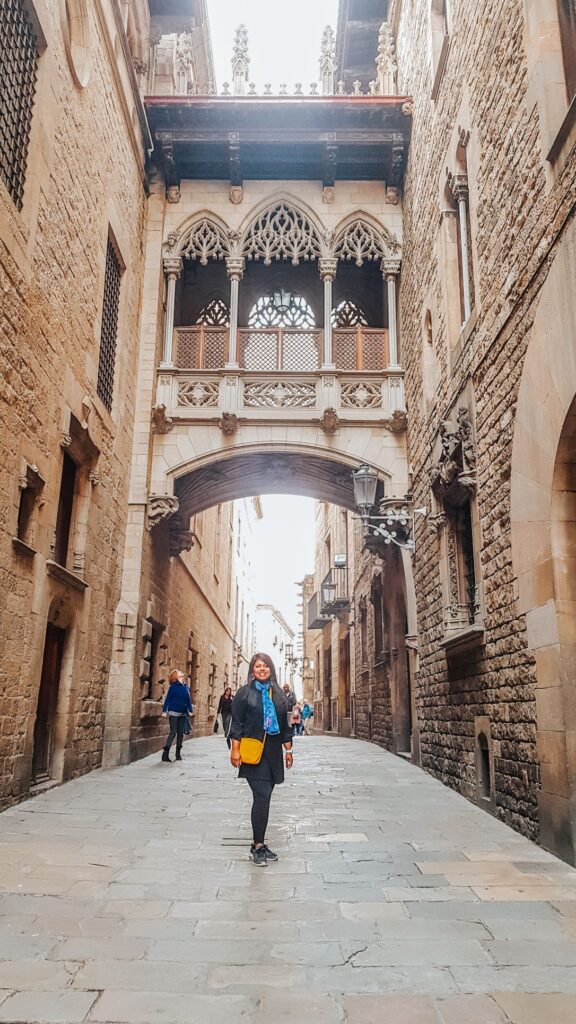
January Highlight: The absence of tourist crowds means you can enjoy a more peaceful exploration of the Roman Wall and other historical sites. Winter lights create a cozy atmosphere, perfect for evening strolls.
5. El Born District and Picasso Museum
Explore the artistic side of Barcelona in the El Born district, home to the Picasso Museum. Barcelona’s Museu Picasso holds one of the largest collections of Picasso’s works, especially his formative pieces. The museum, located in El Born, is housed in five medieval palaces, which alone are worth seeing. January is an ideal time to visit because it’s quieter, allowing you to linger over the exhibits without rushing.
Visitor Tip: If you visit on a Thursday evening after 6 pm or on the first Sunday of the month, admission is free.
6. Magic Fountain of Montjuïc
Located at the base of Montjuïc Hill, the Magic Fountain of Montjuïc is a popular attraction for its nightly light and music shows. While the colder months reduce the frequency of shows, the fountain still operates on select evenings in January, offering a dazzling display of lights, water, and music.
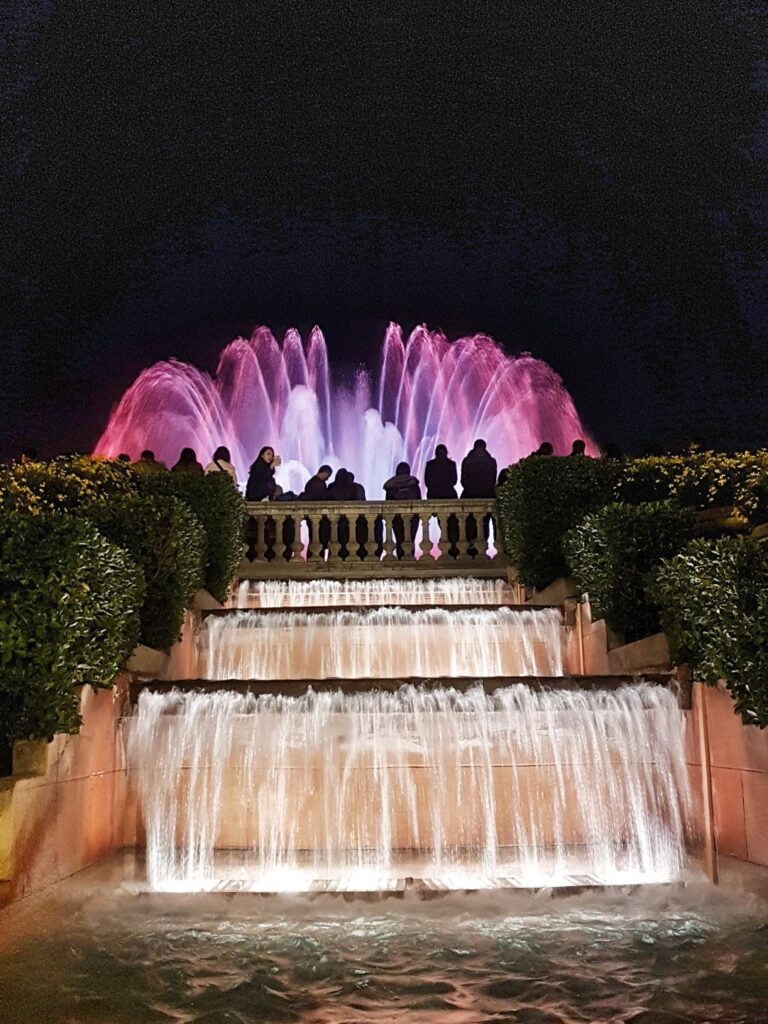
Insider Tip: Check the schedule ahead of time, as shows may be more limited in winter. Click here for a schedule of the show. Grab a warm drink and enjoy the spectacle under the stars.
7. Montjuïc Castle and Cable Car
Perched atop Montjuïc Hill, Montjuïc Castle is a historic fortress that offers panoramic views of the city and the Mediterranean Sea. In January, the chilly breeze on the hill is a refreshing change from the heat of other seasons. You can take the Montjuïc Cable Car to the top for breathtaking aerial views of Barcelona.
January Highlight: Clear skies during winter provide stunning visibility, making it the best time to enjoy the views of the city’s skyline and coastline.
8. Palau de la Música Catalana
A UNESCO World Heritage site, the Palau de la Música Catalana is a stunning example of Catalan modernism. The concert hall, with its ornate stained-glass skylight, is a must-visit in Barcelona. In January, catch a classical music performance or simply tour the building to admire its beauty. In this guided tour, you can explore the modernist architecture of the Palau de la Música Catalana, with access to areas of the iconic building normally off-limits to the public.
9. Take a Ski trip to Andorra
Taking a ski trip to Andorra for the weekend is a perfect winter getaway from Barcelona. Just a three-hour drive or bus ride away, Andorra offers world-class skiing and snowboarding in the stunning Pyrenees Mountains. Popular ski resorts boast excellent slopes for all skill levels, from beginners to seasoned skiers. Beyond skiing, Andorra also offers après-ski activities like thermal spas, shopping in its duty-free stores, and scenic mountain views. With its close proximity and diverse range of winter activities, Andorra makes for an ideal escape to enjoy fresh snow and mountain air over a weekend.
10. Ride the Hop on Hop off Bus
The Hop-On Hop-Off Bus in Barcelona is one of the most convenient ways to explore the city’s top attractions. This double-decker bus offers a flexible sightseeing experience, allowing you to jump on and off at various stops throughout the city. The bus covers key landmarks like La Sagrada Familia, Park Güell, Casa Batlló, and Montjuïc, providing informative audio guides in multiple languages along the way. With panoramic views from the upper deck, it’s perfect for both first-time visitors and those looking to cover a lot of ground quickly. The tickets are valid for a full day or two, giving you the freedom to explore Barcelona at your own pace.
Final Thoughts
Barcelona in January is a time to experience the city without the crowds, offering a peaceful yet vibrant atmosphere. From Gaudí’s masterpieces to traditional festivals, winter cuisine to nearby day trips, there’s no shortage of activities to enjoy. Whether you’re exploring iconic landmarks like La Sagrada Familia, indulging in churros and hot chocolate, or venturing out to nearby Girona, Barcelona in January promises a delightful and unique experience.
Ready to explore Barcelona in January? Book your tickets now and discover a side of the city that’s quieter, more affordable, and full of hidden gems waiting to be explored!
What to Eat in Barcelona in January
Catalan cuisine shines during the colder months, offering hearty and comforting dishes perfect for warming up after a day of exploring.
1. Escudella i Carn d’Olla
This classic winter dish is often served on Christmas but remains popular throughout January. A two-part stew, Escudella starts with a broth made from meat, vegetables, and large pasta shells called galets. It’s hearty, nourishing and ideal for chilly days. You can find this dish at many local Catalan restaurants, especially during the colder months, and it’s a staple around Christmas.
2. Calçots with Romesco Sauce
January marks the start of the Calçot season, a type of green onion that’s traditionally grilled over an open flame until charred, peeled by hand, and served with romesco sauce. Many restaurants in Barcelona offer calçotadas, where you can enjoy these smoky onions as part of a communal meal.
3. Churros and Hot Chocolate
Nothing beats a crisp January morning like a plate of churros with thick, rich hot chocolate. Barcelona is home to some excellent churrerías where you can enjoy this sweet treat. Visit Granja Dulcinea or Churrería Laietana for an authentic experience. You can also find a good selection of cafés serving sweet treats on Petritxol street, which is tucked away on one side of Las Ramblas.
4. Canelons
Though originally an Italian dish, Canelons are a Barcelona staple during the winter months. These pasta tubes are stuffed with meat and topped with béchamel sauce before being baked to perfection. It’s comfort food at its finest that can be found at most traditional restaurants in Barcelona.
5. Botifarra amb Mongetes
A classic Catalan dish consisting of grilled botifarra sausage served with white beans. The sausage is mildly spiced and pairs beautifully with the hearty beans, perfect for colder days.This dish is a staple at Catalan taverns and traditional restaurants, especially in the winter.
6.Patatas bravas
These are one of Spain’s most famous tapas, consisting of crispy, fried potato cubes topped with a spicy brava sauce made from tomatoes, paprika, and sometimes a touch of chili. In Barcelona, they’re often served with a side of aioli, offering a creamy contrast to the bold, spicy sauce. It’s the perfect dish to share over drinks with friends at a local tapas bar.
7.Fideuà:
This seafood dish issimilar to paella, but instead of rice, it’s made with short, thin noodles. Originating from the Valencian coast, it’s typically cooked in a wide, shallow pan with a mix of seafood like prawns, clams, and squid, then simmered in a flavorful fish stock. The dish is often topped with a dollop of garlicky aioli for added richness.
8.Esqueixada
A refreshing dish made with shredded salt cod (bacalao), tomatoes, onions, olives, and drizzled with olive oil. Although light, it’s available year-round and often enjoyed as a starter or a light lunch. Local tapas bars and Catalan restaurants often feature esqueixada on their menus.
9.Turrón
Though traditionally eaten during Christmas, turrón (a type of nougat) is often available in January as well. It’s made with honey, sugar, egg whites, and toasted almonds, and comes in hard (turrón duro) or soft (turrón blando) varieties. Many bakeries and sweet shops in Barcelona sell turrón, and you’ll find it on the dessert menus of many restaurants.
10.Crema Catalana
A rich custard dessert, similar to French crème brûlée, but with a lighter, citrus-infused flavor. It’s topped with a layer of caramelized sugar that cracks with a spoon. Crema Catalana is a popular dessert year-round, available at most Catalan restaurants.
These are just a few of the delicious foods you can try in Barcelona in January. Whether you’re looking for hearty stews, light bites, or sweet treats, there’s something for everyone to enjoy. Be sure to visit one of the city’s many markets, such as La Boqueria, for a taste of the freshest and most authentic local cuisine.
Day Trips from Barcelona in January
Barcelona’s location makes it the perfect base for exploring the surrounding Catalonia region. January’s mild weather means you can comfortably enjoy day trips to nearby towns and landmarks without having to worry about the scorching heat of the sun.
1. Montserrat
A day trip to the Montserrat mountain range is a must when visiting Barcelona in January. Home to a stunning monastery, Santa Maria de Montserrat, the area is rich in history, religious significance, and breathtaking views. The cooler weather and clear skies make it a pleasant time to hike up the mountain or take the funicular.
Travel Tip: Try to arrive early in the morning to avoid fog covering the mountain peaks. This gives you the best chance to admire the scenic views of Catalonia.
2. Girona
Girona is a charming medieval city just a 40-minute train ride from Barcelona. January is one of the best times to visit, as the lack of crowds allows you to fully appreciate the city’s historic center, including its Cathedral, Jewish Quarter, and the Onyar River with its colorful houses. Girona is also famous for being a filming location for Game of Thrones, making it a must-see for fans.
3. Sitges
If you’re craving a coastal escape, the town of Sitges is just 30 minutes from Barcelona. Known for its beaches, bohemian culture, and arts scene, Sitges is a great place to explore in winter when it’s far less busy. Walk along the seafront promenade, visit the Maricel Museum, or simply enjoy the laid-back vibe of the town.
Festivities to Enjoy in Barcelona in January
1. Three Kings Parade (Cavalcada de Reis)
One of the most vibrant and anticipated events in Barcelona during January is the Cavalcada de Reis or Three Kings Parade. Held on the evening of January 5th, the parade sees the arrival of the Three Wise Men, who march through the city on elaborately decorated floats, throwing candy to excited children. It’s a magical experience for families and offers a glimpse into Spain’s rich traditions.
2. Sant Antoni Festival
Taking place in mid-January, the Festes de Sant Antoni honors Saint Anthony, the patron saint of animals. The highlight is the Tres Tombs Parade, where locals bring their pets, including horses, donkeys, and dogs, to be blessed in front of the Sant Antoni Abat Church. The festival also includes bonfires, traditional dances, and street fairs.
3. Barcelona’s Winter Sales (Rebajas de Invierno)
January marks the start of Barcelona’s famous Rebajas de Invierno, or winter sales. This is the best time to shop for bargains, as major brands and independent boutiques slash prices on clothing, shoes, electronics, and more. The sales typically run from January 7th to the end of February, making it an ideal time to stock up on quality goods.
Travel Tips for Visiting Barcelona in January
- Pack Layers: Although Barcelona enjoys mild winters, it can still get chilly, especially in the evenings. Bring layers, including a warm jacket, scarf, and comfortable shoes for walking.
- Take Advantage of Reduced Prices: January is off-season for tourism, so you can often find cheaper accommodations, especially in areas like El Raval and Poble Sec. Book in advance to secure the best deals.
- Use Public Transport: Barcelona’s public transport system is efficient and affordable, with buses, trams, and the metro making it easy to get around the city and beyond. Consider purchasing a T-10 ticket for unlimited travel on all public transport for 10 trips.
- Check Attraction Schedules: While many attractions remain open year-round, some museums or smaller attractions may have reduced hours in January. Be sure to check opening times before visiting.
FAQ: Visiting Barcelona in January
Q: Is January a good time to visit Barcelona?
A: Yes! January is an excellent time to visit if you want to avoid crowds and enjoy milder temperatures. You’ll also benefit from cheaper accommodations and winter sales.
Q: What should I pack for a January trip to Barcelona?
A: Bring layers, as daytime temperatures are mild, but it can get cooler in the evenings. A warm jacket, scarf, and comfortable shoes for walking are recommended.
Q: Are there any special events in Barcelona in January?
A: The Three Kings Parade on January 5th and the Sant Antoni Festival in mid-January are two of the main events. Additionally, January is the start of the winter sales, perfect for shopping enthusiasts.
Q: Is Barcelona cold in January?
A: Barcelona experiences mild winters. Average temperatures in January range between 8°C (46°F) and 15°C (59°F), making it comfortable for outdoor activities with the right clothing.
Q: Are there fewer tourists in January?
A: Yes, January is one of the least crowded months to visit Barcelona, allowing for more leisurely sightseeing without long lines.
Q: What should I pack for Barcelona in January?
A: Pack layers, including a light jacket, scarves, and a travel umbrella. Comfortable walking shoes are also essential.
Q: Are attractions open in January?
A: Most of Barcelona’s main attractions, including La Sagrada Familia and Park Güell, are open year-round. However, it’s always good to check hours as some places may have shorter winter hours.
Note: The information here is updated the best we can at the time of writing this article. Please check attractions, activities, and transport before your trip as things tend to change from time to time.

